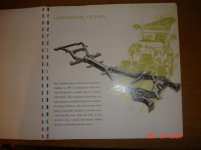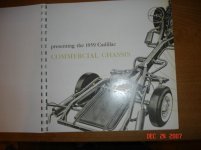Hello, my name is Eric Hufstutler. I live in Richmond, VA and this is my first post here. I hope I am doing this correctly since I do not own a commercial or professional vehicle even though I would like to and my best friend works at a funeral home and drives their cars all of the time.
My interest is that I am in the process of gathering information for a book about chassis history and design, in particular the X-braced, X or Cruciform types on all vehicles. Currently I am working on the Tubular Center X style introduced on the 1957 Cadillac. I have a request and also a couple of questions in which may sound a bit strange and even more so in the way I will describe it so here it goes.
I am seeking hi res scans of the bare frame chassis ads seen in trade magazines for the 1957 Cadillac and the post 1965 style sans the X . That part wasn't that difficult to ask but this history question is.
It appears that the original design of this frame dates back to 1951 in tests prior to its intended original use on the 1957 Eldorado Brougham. But initially it had the triangulated shaped rear side rails under the trunk area which was seen as late as January 1957 in SAE Journals and promotional information. This car was delayed more than a year as they tweaked it and seems like the frame shape was altered as a last minute decision due to the problematic air suspension system and made more traditionally square. While the other Cadillac lines for 1957 only used the original triangulated shaped frame with leaf springs but changed also to squared in 1958... except for commercial chassis. The limousine made by Cadillac used the standard frame extended with squared rear section (post 1957) while they shipped off the odd shaped triangular frames for commercial use between 1957-1964. Commercial 1965 used the new 1965 perimeter torque box frame chassis while the Cadillac limo carried over the 1964 design.
1) Why did Cadillac use this odd design triangulated frame with triangle shaped gas tank on commercial vehicles - and for so many years?
2) Why did the factory made limousine for 1965 use the old 1964 body and chassis design?
Whew, hope I didn't loose anyone but if I did, please let me know and I'll try to clarify this.
And I would be greatly appreciative of any other commercial vehicle with X braced or X frames other than Cadillac with frame diagrams or ads, especially more unusual cars which I will gladly give a credit line for in the book.
Many Thanks ahead of time!
Eric
My interest is that I am in the process of gathering information for a book about chassis history and design, in particular the X-braced, X or Cruciform types on all vehicles. Currently I am working on the Tubular Center X style introduced on the 1957 Cadillac. I have a request and also a couple of questions in which may sound a bit strange and even more so in the way I will describe it so here it goes.
I am seeking hi res scans of the bare frame chassis ads seen in trade magazines for the 1957 Cadillac and the post 1965 style sans the X . That part wasn't that difficult to ask but this history question is.
It appears that the original design of this frame dates back to 1951 in tests prior to its intended original use on the 1957 Eldorado Brougham. But initially it had the triangulated shaped rear side rails under the trunk area which was seen as late as January 1957 in SAE Journals and promotional information. This car was delayed more than a year as they tweaked it and seems like the frame shape was altered as a last minute decision due to the problematic air suspension system and made more traditionally square. While the other Cadillac lines for 1957 only used the original triangulated shaped frame with leaf springs but changed also to squared in 1958... except for commercial chassis. The limousine made by Cadillac used the standard frame extended with squared rear section (post 1957) while they shipped off the odd shaped triangular frames for commercial use between 1957-1964. Commercial 1965 used the new 1965 perimeter torque box frame chassis while the Cadillac limo carried over the 1964 design.
1) Why did Cadillac use this odd design triangulated frame with triangle shaped gas tank on commercial vehicles - and for so many years?
2) Why did the factory made limousine for 1965 use the old 1964 body and chassis design?
Whew, hope I didn't loose anyone but if I did, please let me know and I'll try to clarify this.
And I would be greatly appreciative of any other commercial vehicle with X braced or X frames other than Cadillac with frame diagrams or ads, especially more unusual cars which I will gladly give a credit line for in the book.
Many Thanks ahead of time!
Eric
Last edited:



